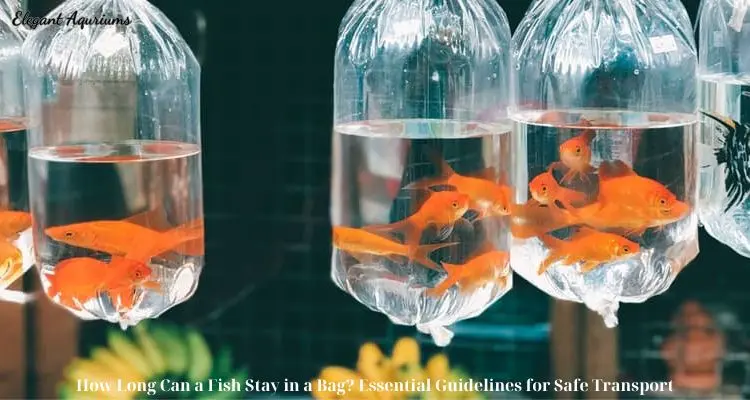Fish care
How Long Can a Fish Stay in a Bag? Essential Guidelines for Safe Transport
Understanding Fish Transport
When transporting fish, it’s essential to recognize the challenges they face during the process. Fish are sensitive to changes in their environment, and prolonged exposure to confined spaces can lead to stress, deterioration of water quality, and potential health issues.
The Basics of Fish Transport
- Water Quality: The quality of the water in the bag is crucial. Fish produce waste, which can quickly accumulate and affect the water’s pH, ammonia, and oxygen levels. Proper water management is essential to maintain a safe environment.
- Oxygen Levels: Fish need adequate oxygen to survive. In a confined bag, oxygen levels can deplete quickly, especially if the bag is tightly sealed. Ensuring that the bag has enough oxygen and can be properly ventilated is key to a successful transport.
- Temperature: Temperature fluctuations can stress fish and impact their health. Maintaining a stable temperature during transport is vital to prevent thermal shock and other temperature-related issues.
How Long Can a Fish Stay in a Bag?

The duration a fish can safely remain in a bag depends on various factors, including the fish species, bag size, water quality, and environmental conditions. Generally, fish can stay in a bag for 1 to 2 hours without significant risk. However, this timeframe can vary based on several key factors.
Fish Species
Different fish species have varying tolerances for stress and environmental changes. Hardy species, like goldfish or guppies, might endure longer periods in a bag compared to more sensitive species like discus or marine fish. Understanding the specific needs of your fish is vital for determining how long they can stay in a bag safely.
Bag Size and Water Volume
The size of the bag and the amount of water in it significantly impact how long a fish can stay in the bag. A larger bag with more water provides better conditions for the fish by allowing for more oxygen and reducing the concentration of harmful waste products. Small bags with limited water volume can quickly become unsafe, as they may lead to faster depletion of oxygen and accumulation of toxins.
Oxygen Levels
Oxygen depletion is a major concern when transporting fish. As fish breathe, they consume oxygen from the water and release carbon dioxide. In a sealed bag, the oxygen levels can drop rapidly, especially if the bag is small and overcrowded. To extend the time fish can stay in a bag, ensure that the bag has adequate oxygen and consider using oxygenated water or an air pump during transport.
Temperature Control
Temperature stability is crucial for fish health. Fish are sensitive to temperature fluctuations, which can cause stress and potentially lead to health issues. If the bag’s water temperature deviates significantly from the fish’s optimal range, it can increase the risk of stress and illness. Keeping the bag at a stable temperature during transport is essential for maintaining fish well-being.
Factors Affecting Fish Health During Transport
To ensure fish remain healthy during transport, several factors need to be managed carefully.
Water Quality
The quality of the water in the bag plays a crucial role in the fish’s well-being. Poor water quality, characterized by high levels of ammonia, nitrite, and other toxins, can quickly become harmful. To prevent this, use clean, dechlorinated water and avoid overcrowding the bag. Additionally, including a small amount of a water conditioner can help neutralize potential toxins.
Stress Reduction
Minimizing stress is vital for fish health during transport. Stress can weaken the immune system and make fish more susceptible to disease. Handle fish gently and avoid sudden movements or loud noises. Keeping the transport environment calm and stable will help reduce stress levels.
Bag Handling
Proper handling of the bag is essential to avoid injury or additional stress to the fish. Ensure that the bag is securely closed to prevent leaks and avoid rough handling. If possible, use a soft, insulated container to transport the bag and minimize jostling.
Tips for Successful Fish Transport
To ensure the health and safety of fish during transport, follow these best practices:
Preparation Before Transport
- Choose the Right Bag: Use a clean, sturdy bag that provides enough space for the fish. For longer transports, consider using larger bags or multiple bags.
- Prepare the Water: Use dechlorinated water that matches the temperature and pH of the fish’s home aquarium. Adding a water conditioner can help manage toxins.
- Add Oxygen: For longer journeys, consider using an oxygen pump or oxygen tablets to ensure adequate oxygen levels in the bag.
During Transport
- Maintain Temperature: Keep the bag at a stable temperature by using an insulated container or placing it in a temperature-controlled environment.
- Minimize Stress: Avoid excessive handling or exposure to bright light. Keep the transport environment as calm as possible.
- Monitor the Bag: If possible, check on the bag periodically to ensure that the fish are in good condition and that there are no leaks.
After Transport
- Acclimate the Fish: When you reach your destination, acclimate the fish slowly to their new environment. Float the bag in the aquarium to equalize temperatures and gradually mix aquarium water into the bag before releasing the fish.
- Monitor Health: After introduction, closely observe the fish for signs of stress or illness. Ensure that the new environment meets their needs and address any issues promptly.
Common Problems and Solutions
Oxygen Depletion
Problem: Oxygen levels in the bag drop too low, leading to potential health issues for the fish.
Solution: Use a larger bag with more water, consider adding an oxygen source, and avoid overcrowding. If you notice the bag is becoming too low in oxygen, transfer the fish to a new bag or aquarium as soon as possible.
Temperature Fluctuations
Problem: Temperature changes during transport can stress the fish.
Solution: Keep the bag in a temperature-stable environment and use insulated containers to maintain a consistent temperature. Avoid placing the bag in direct sunlight or cold areas.
Water Quality Issues
Problem: The water in the bag becomes toxic due to waste accumulation.
Solution: Use clean, dechlorinated water and avoid adding too many fish to a single bag. For longer transport times, consider using water conditioners to manage toxins.
Conclusion
Understanding how long a fish can stay in a bag is essential for ensuring their well-being during transport. By following best practices for bag preparation, water management, temperature control, and minimizing stress, you can provide a safe and comfortable journey for your aquatic pets.
Whether you’re transporting fish from a store, shipping them, or relocating them, careful planning and attention to detail are key. With proper care and management, you can help ensure a smooth transition for your fish and maintain their health and happiness.











